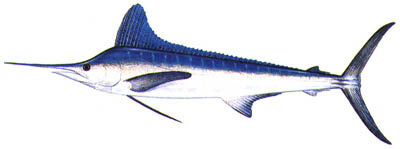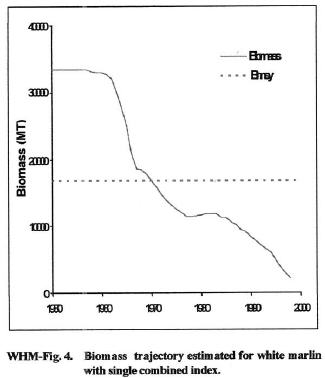
What Do YOU Think?

Some formatting was lost on conversion to html. Contact us if you would like a correct version e-mailed or mailed to you.
2000 Stock Assessment for White Marlin

Become a Sponsor- Help protect marlin, bluefin tuna, swordfish, sailfish and the other large pelagic species by supporting our work financially. To do so, go to: BigMarineFish.com/sponsor.html
Get political - contact your federal officials, including your two Senators and your Representative in Congress.
BACKGROUND
On September 3, 2002, the National Marine Fisheries Service (NMFS) announced it had chosen not to list the white marlin as endangered. (NMFS did NOT address whether the species should be listed as threatened.) In doing so, NMFS admitted that by the end of 2000 the population had declined to 6% of its carrying capacity (the "virgin" abundance existing before longlining began in 1960) and that it had been declining steadily by 3% each year since 1982. However, incredibly, NMFS took the position that only when the species' abundance had declined to 1% of its carrying capacity would it consider white marlin at risk of extinction. At the white marlin's current rate of decline (depicted in the graph above) and without further significant reductions in its mortality, that should occur in less than 5 years. In doing nothing, NMFS has chosen to protect the longliners rather than the white marlin.
OUR RESPONSE
On September 18, 2003, the Center for Biological Diversity (CBD) and the Turtle Island Restoration Network (TIRN) jointly served notice to the Secretary of Commerce and Director of NMFS that they intended to sue in federal court within 60 days. Specifically, CBD and TIRN stated "NMFS's determination that listing of the white marlin is "not warranted" violates the specific mandates of the ESA ... Such determination is arbitrary and capricious ... If NMFS does not act within 60 days to correct this violation of the ESA, the Center for Biological Diversity and Turtle Island Restoration Network will pursue litigation in Federal Court against NMFS." A copy of the 60-day notice can be found here.
On January 14, 2004, the lawsuit was filed in U.S. District Court. A copy of the press release can be found
here and a copy of the formal complaint (18 pages) can be found
here.
Settlement talks are underway focused on achieving the following:
TO SAVE THE WHITE MARLIN, PROHIBIT LONGLINES IN THEIR
"HOT SPOTS"
See the maps (links below entitled Critical Habitat Maps) showing the North Atlantic white marlin's critical habitat - its primary spawning and feeding areas. We call them their "hot spots." To
read our recommendations to NMFS on which areas should be closed to longlines as "critical habitat" of North Atlantic white marlin and blue marlin, see the link below (entitled "Hot Spots" are the White Marlin's Critical Habitats).
To see maps of the locations of our recommended longline closures to
protect white marlin, click
here.
"Hot spots" that should be closed are not just the areas where the longliners fish most heavily. As can be seen in the following plots showing the yearly extent of U.S. longline vessels' sets (1992,
1995,
1996 and
1997), longliners are covering a much greater area of the North Atlantic than just the area of these "hot spots." In fact,
we estimate that closing all the white marlin's "hot spots" in the North Atlantic would deny U.S. longliners access to only about 2% of the area they normally fish. But, it would eliminate about 85% of their
often fatal interactions with white marlin.
This is important because, based on all the information available, we are convinced that there is not one Atlantic-wide population of white marlin, but two. The South Atlantic population appears to spawn off the northern coast of Brazil (Royal Charlotte Bank area) during late spring-early summer in the southern hemisphere (probably peaking in November-early December). The North Atlantic population ("our" white marlin) spawns in the Caribbean region during late spring-early summer (peaking in May-early June). From 10 years of longline catch records by quarter we know that it is concentrated in the large gaps between the larger islands of the Caribbean (such as the Mona Passage between the Dominican Republic and Puerto Rico where large concentrations of larval white marlin have recently been found). Thus, spawning by the North and South Atlantic populations of white marlin occurs 6 months apart and the two centers of spawning activity are 4,000 miles apart. Clearly, this is not a single Atlantic-wide population but two entirely distinct populations that do not interbreed. (The same is already accepted by the international scientific community for swordfish - 2 separate and distinct populations.) Overfishing on one population thus has absolutely no effect on the other.
We may not be able to save white marlin of the South Atlantic because that is totally dependent on international agreements at ICCAT. But, the U.S. can unilaterally protect the North Atlantic population to a great extent by prohibiting longlining in the white marlin's "hot spots" that are located in U.S. waters. This is true simply because, except for spawning, most of this population's members apparently spend a large part of their adult life in U.S. waters. It is important to understand that these same "hot spots" are also used at the same time of year and for the same purposes (spawning and feeding) by the North Atlantic swordfish and North Atlantic blue marlin. So, closing them to longlines will markedly benefit these two distinct populations as well.
Be sure to see the other sections of this website
(links are below) for details on the population declines of each of the Atlantic Ocean's big fish.
GET INVOLVED YOURSELF
If you want to help us prevent this species from sliding into extinction (as well as help protect declining populations of Atlantic blue marlin, swordfish, bluefin tuna, bigeye tuna, mako sharks, spearfish, sailfish and many other large pelagic species) become a Sponsor and support our efforts financially. You can also write to the Director of NMFS about the agency's approach to its responsibility for stewardship of our nation's living marine resources. Address your letter to Dr. William T. Hogarth, Assistant Administrator for Fisheries, NOAA/NMFS, 1315 East-West Highway, Silver Spring, MD, 20910, USA. (Email messages are not considered by NMFS as public comment.) Encourage others who care about the well-being of all these fish to do the same.
Swordfish, Marlin, Sailfish, Tunas and Sharks
Recommended "Hot
Spot" Closures to Longlines
Critical Habitat Maps - White Marlin
Critical Habitat Maps - Blue Marlin
"Hot Spots" are the White Marlin's Critical Habitats
The Severity of Atlantic Population Declines (by species)
Articles about Big Game Fish and Fishing
Photos of Big Game Species
Wetlands, Estuaries, Rivers and Coastal Habitat
Importance to Marine Fish
Chambers and Associates
Description
Become a Sponsor
List of All Pages on this Website
Home

9814 Kensington Parkway
Kensington Maryland 20895-3425
(T) 301-949-7778 (Fax) 301-949-3003